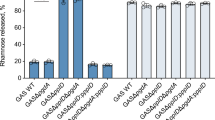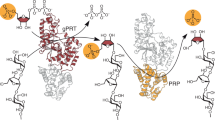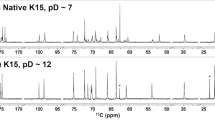Abstract
THOUGH a large number of antigenic capsular polysaccharides of Pneumococcus are known to contain one or more amino-sugars1, in only one case, namely, 2-amino-2-deoxy-D-glucose (D-glucosamine) from type XIV polysaccharide2, has the amino-sugar been isolated and characterized. Two amino-sugars, designated ‘pneumosamine’ and ‘amino-sugar X’ have been isolated from purified Type V Pneumococcus capsular polysaccharide3, and preliminary investigations, which included analysis of the crystalline N-acetamido alcohol derivatives, indicated that both sugars were 2-amino-2,6-dideoxyhexoses. Kuhn-Roth determinations on ‘N-acetylpneumosaminol’ (1.52 moles CH3) and on ‘amino-sugar X’ (0.68 mole CH3) support the postulated 6-deoxyhexosamine structure. The sugars have now been tentatively identified as 2-amino-2,6-dideoxytalose (pneumosamine) and 2-amino-2,6-dideoxy-L-galactose (amino-sugar X). The sugars were isolated from a polysaccharide hydrolysate (hydrolysis conditions: 2 N hydrochloric acid, 24 hr., 100°) by chromatography on ‘Dowex-50’ resin4. The acidic effluents were neutralized with ‘Deacidite FF’ (carbonate form), lyophilized and the syrupy residues dried in vacuo over phosphorus pentoxide. Treatment of the ‘pneumosamine’ residue with methanol gave ‘pneumosamine hydrochloride’ melting point 162–3° (from methanol–ether); [α]18 D + 6.9° (10 min.), → + 10.4° equil. (cone. 2.3 in water). Found: C, 35.9; H, 7.4 per cent; calc. for C6H14O4NCl: C, 36.1; H, 7.1 per cent. ‘Amino-sugar X’ was crystallized from a water–methanol–acetone mixture.
This is a preview of subscription content, access via your institution
Access options
Subscribe to this journal
Receive 51 print issues and online access
$199.00 per year
only $3.90 per issue
Buy this article
- Purchase on Springer Link
- Instant access to full article PDF
Prices may be subject to local taxes which are calculated during checkout
Similar content being viewed by others
References
Stacey, M., and Barker, S. A., Polysaccharides of Micro-organisms, 114 (Oxford Univ. Press, 1960).
Barker, S. A., Heidelberger, M., Stacey, M., and Tipper, D., J. Chem. Soc., 3468 (1958).
Barker, S. A., Stacey, M., and Williams, J. M., Bull. Soc. Chim. Biol. (in the press).
Gardell, S., Acta Chem. Scand., 7, 207 (1953).
Foster, A. B., Chem. and Indust., 1050 (1952).
Foster, A. B., Chem. and Indust., 591 (1953).
Mills, J. A., J. Chem. Soc., 260 (1953).
Martlew, E. F., Ph.D. thesis, University of Birmingham (1954).
Bera, B. C., Foster, A. B., and Stacey, M., J. Chem. Soc., 4531 (1956).
Levene, P. A., J. Biol. Chem., 39, 69 (1919).
Fischer, E., and Tiemann, F., Chem. Ber., 27, 138 (1894).
Kuhn, R., and Brossner, R., Ann. Chem., 616, 221 (1958).
Author information
Authors and Affiliations
Rights and permissions
About this article
Cite this article
BARKER, S., BRIMACOMBE, J., HOW, M. et al. Two New Amino-Sugars from an Antigenic Polysaccharide of Pneumococcus . Nature 189, 303–304 (1961). https://doi.org/10.1038/189303a0
Issue Date:
DOI: https://doi.org/10.1038/189303a0
This article is cited by
-
Isolation of D-Fucosamine from Bacillus cereus
Nature (1964)
Comments
By submitting a comment you agree to abide by our Terms and Community Guidelines. If you find something abusive or that does not comply with our terms or guidelines please flag it as inappropriate.



